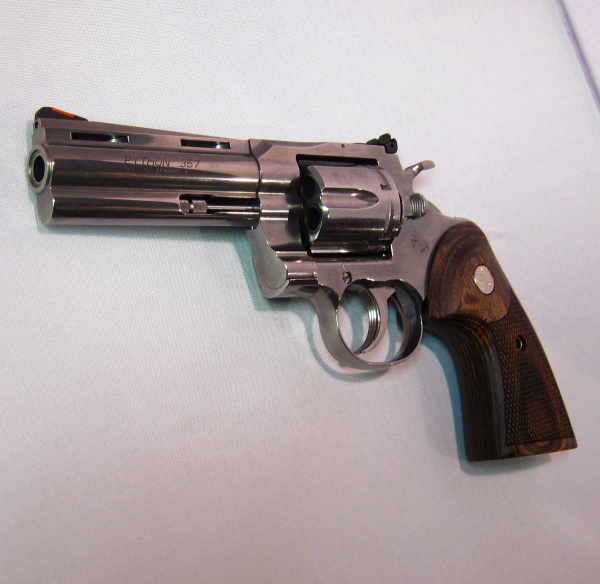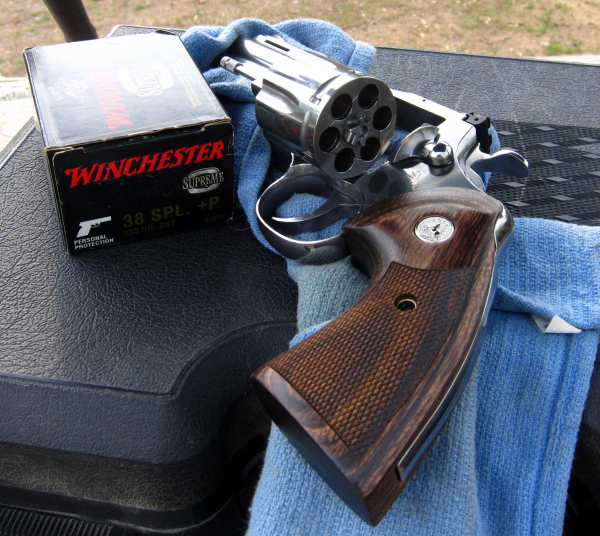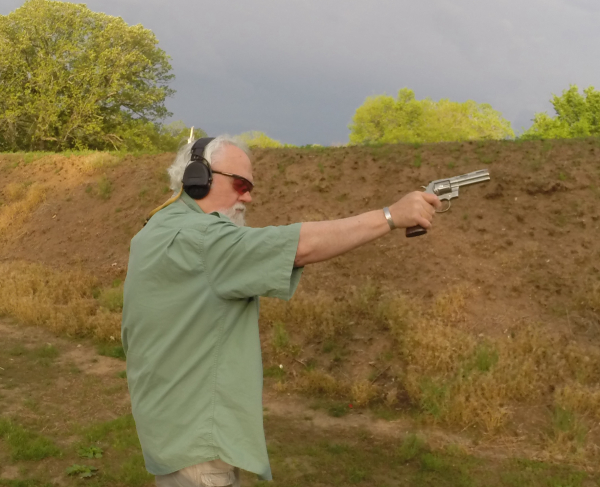
The story I’d gotten that, aside from hand fitting and exceptional bore finish and rate of twist, the Python barrel featured a slightly tapered bore, all contributing to the remarkable accuracy. As there’s a 2020 Colt Python in the shop, it was time to ask Justin Baldini, Product Director at Colt, about the original heater as well as about the new one.
The current sample is the 4 ¼” Colt Python, stainless steel. Also available with a six-inch barrel, the new snake is reengineered for modern manufacture, build strength, and features a recessed barrel crown, user-changeable front sight and walnut stocks. Like the earlier production, the Python is a 357 Magnum, meaning it’s useable for the earlier and weaker .38 Special cartridge.
It weighs in at 42 ounces, compared to a 4” S&W M686 at around 40 ounces and the Ruger GP100 4.2” right at 40 ounces. The underlug, vent rib and Colt-target style stocks remind me of the original. The finish is a satin appearance, not the gloss shine of the originals.
The trigger is sharp-edged and grooved; the backstrap is smooth. The hammer features a ‘beavertail’ spur for manual cocking. I found the single action press to be solid and firm, more in keeping with the feel of a GP100 in single action. The double action featured the slightest stack (increase in effort toward the end), but very smooth. The red ramp is quite visible for me, but the shallow rear notch of the current rear sight is disconcerting.

The good news is, I noticed that in dry practice but lost it in the concentration of live fire. The ease of replacing the front sight is an overwhelming advantage. As to the rear, I’d hope someone will arrive at an after-market solution as I don’t see it enough of a problem for Colt to change.
On the contrary, the compact nature of the rear sight and its fitment gives a robust top strap treatment.
Range time has been at a premium due to the viral insanity and spring monsoons. I was able to get the 2020 Python out just in advance of dangerous thunderstorms a couple of days ago. I didn’t shoot it a lot, but I intentionally used ammo that would take me back to an earlier time.
I started with some old Winchester “Supreme” 130 grain SXT +P that had been indifferently cared for over the decades. At ten yards, using a center hold, the first 11 rounds out of the gun (it was all I had) clustered low and left making it appear for all the world that I have a consistent ‘flinch.’


The second load I tried was the Federal American Eagle 357 Magnum 158 grain JSP. An analog to the ammo first purchased for me – I was only 18 when I did the private purchase of my first Python and you had to be 21 to buy ammo – the load was close to the Federal 158 grain JSP of 1972. Just because I was a GI who fired the XM16E1, M60 and M79 in BCT, I couldn’t be allowed to purchase revolver ammo . . .
The current American Eagle stuff was reasonably stout and, like the +P, tended a little low and left at fifteen yards. It could be I need a sight adjustment – or I need to adjust my hold.
The confirmation came with the outstanding Black Hills 148 grain Wadcutter load, similar to what I’d used in my bullseye match of 41 years ago. Shooting one-handed from 15 yards, I went about an inch left and about 2” low, nicely clustered.
In the short term, what would I change? I’d have the edges on the face of the trigger rounded first – it’s too sharp for DA shooting. I’d change stocks, but that’s the joy of shooting revolvers – you can make them fit.

I don’t think I’d change a single other thing right now. Maybe more shooting will help, if I can get the weather gods and the beer virus to cooperate.
As to internal differences, Jason did some asking around from folks present back when the Python was a hand-fitted work of art. He was told – by someone who would know – that there was no taper in the bore of the originals. Some measurement would confirm that, but I like legends, so I’ll let that be. Why so accurate then?
“They were just well manufactured barrels.”
As to the “laser boresighting,” at the time I figured they just put a laser fixture in the forcing cone while the gun was chucked into a vise and the sights were adjusted onto the ‘dot’ appearing on a target downrange. I’m not sure how relevant it was, but the marketing people must have figured it would sound good.
The new gun has 12 fewer parts of which nine are in the action. How’d they do it? By combining what had previously been “assemblies” into single parts. “For instance the hand was two pieces assembled, now it’s one piece. The link that connects the hammer to the mainspring was also an assembly. In addition, the change from hammer block to transfer bar simplified things.”
In testing and development, Colt consumed 20,000 rounds of ammo through new Pythons as well as over 40,000 trigger presses. That’s the advantage of modern manufacture. It’s part of what that $1499.00 MSRP represents.
Is it the Python of old? Hell no. I’m not what I was 41 years ago either. As a working revolver, I think it could be a great addition. Stout, sturdy, accurate – that’s what it looks like the 2020 Python has going for it.
We’ll see.
- - Rich Grassi